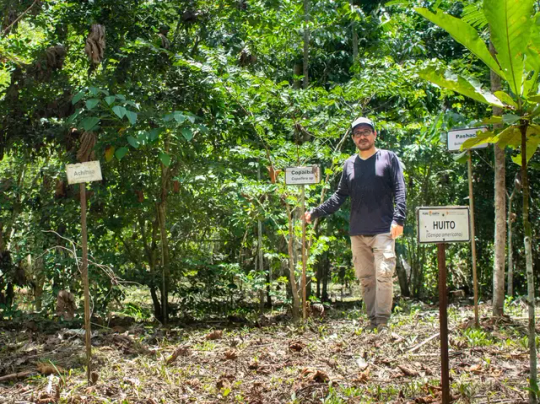#tree planting ngo
Explore tagged Tumblr posts
Text
Growing Green: Aahwahan Foundation's Tree Plantation Initiative
Join us as we embark on a journey to make our planet greener and healthier! Aahwahan Foundation is proud to launch its tree plantation initiative, aimed at fostering environmental sustainability and combatting climate change. Through collaborative efforts and community engagement, we aspire to plant thousands of trees, creating lush green spaces and promoting biodiversity. Together, let's sow the seeds of a brighter, greener future for generations to come. Join hands with Aahwahan Foundation and be a part of the movement towards a more sustainable world.
4 notes
·
View notes
Text
0 notes
Text
Importance of Plantation Projects and how does it impact the Green World
Plantation projects play a key role in creating a sustainable and greener planet by reducing carbon footprints, improving biodiversity, and enhancing air quality. Initiatives like urban planting, reforestation, and agroforestry contribute to a healthier ecosystem and a more beautiful world. They also offer health, aesthetic, and environmental benefits. Every individual’s participation in these projects is vital for a brighter, eco-friendly future.
To know more : https://vanamindiafoundation.org/29/blog_detail
#Sustainability
#GreenPlanet
#PlantationProjects
#EcoFriendly
#ClimateAction
#Reforestation
#Agroforestry
#UrbanGreening
#EnvironmentalConservation
#CarbonOffset
#Biodiversity
#GreenFuture
#EcoInitiatives
#VanamIndiaFoundation
#ClimateChange
#GreenRevolution
#SustainableLiving
#CleanEnvironment
#NatureLovers
#TreePlanting
#GreenSpaces
#organicfarming#greencover#wildlifeconservation#natureconservation#climateaction#youthfornature#ecofriendly#gogreen#ecorevolution#environmentalimpact#Environmental NGO Tamil Nadu#Palladam Coimbatore tree plantation#Coimbatore green initiatives#Eco-conscious foundation Tamil Nadu#South India environmental projects#Vanmazhai tree planting events#Vanam India Foundation events
0 notes
Text
SPNI israeli organization - How it save nature and why we all need to do the same?
SPNI, the Society for the Protection of Nature in Israel, stands as a beacon of conservation and environmental stewardship, spearheading efforts to safeguard Israel's natural heritage for future generations. Through a multifaceted approach that combines advocacy, education, and hands-on conservation initiatives, SPNI works tirelessly to protect the country's diverse ecosystems, wildlife, and landscapes.
One of SPNI's key initiatives is its extensive network of nature reserves and parks, which serve as vital sanctuaries for endangered species and critical habitats. By acquiring and managing these protected areas, SPNI ensures that Israel's unique biodiversity is preserved and accessible to all.
Moreover, SPNI engages in environmental advocacy and policy-making, advocating for sustainable land use practices, wildlife protection laws, and measures to combat climate change. Through grassroots campaigns and partnerships with government agencies and other NGOs, SPNI amplifies the voice of nature and advocates for policies that prioritize environmental conservation and sustainability.
The work of SPNI serves as a powerful reminder of the importance of protecting nature and the urgent need for collective action. As stewards of the planet, we all have a responsibility to safeguard our natural resources, mitigate the impacts of human activities on the environment, and promote a more harmonious relationship between people and nature. By following SPNI's example and taking action to conserve and protect the natural world, we can ensure a brighter and more sustainable future for all. Find more on Todogod and join it:

1 note
·
View note
Text
"In 2024, the United Nations recognized seven landmark projects worldwide as outstanding examples of success under its ongoing Decade on Ecosystem Restoration (2021-2030).
One of them was Acción Andina (Andean Action), an initiative that has launched 25 restoration and conservation projects focused on the high-altitude Polylepis forests of Peru, Chile, Bolivia, Argentina, Ecuador and Colombia.
More than 25,000 people from 200 communities have restored nearly 5,000 hectares (12,400 acres) of these forest and protected more than 11,250 hectares (27,800 acres) of existing woodland.
The initiative next aims to expand into Colombia and Venezuela.
...Co-founded by the nonprofit organizations Global Forest Generation and Andean Ecosystems Association (ECOAN), Acción Andina aims to protect and restore high-altitude Andean forests in Peru, Bolivia, Chile, Argentina and Ecuador, ensuring the preservation of vital water resources for millions of people across the region.
In fact, last February, Acción Andina was recognized by the United Nations as one of seven flagship initiatives for global restoration. The U.N. has declared 2021-2030 as its Decade on Ecosystem Restoration, emphasizing not only the urgent need to conserve remaining natural areas, but to restore what has already been lost...
“We witnessed immense suffering and hardship in the local and Indigenous communities of the Andes,” Aucca recalls. “So, my friends Gregorio Ferro, Efraín Samochuallpa, Willy Palomino and I decided that if we were going to enter the world of conservation, we had to do something for these communities. That’s how ECOAN was born. What sets us apart from other organizations is that we implement conservation initiatives in direct coordination with local actors — ensuring that our work benefits the communities themselves.”
Among friends and colleagues, Constantino Aucca is known simply as “Tino.” He says 2014 was a turning point for ECOAN, driven by his frustration with the empty rhetoric and lack of action on environmental issues at the U.N.’s series of annual climate summits, or conference of the parties (COPs).
“As a group, we decided to send a message to the world that action is possible,” he says. “In a single day, we planted more than 57,000 [queuña] trees high in Huilloc [in Cusco, Peru]. We called the event Queuña Raymi, or the Festival of the Queuñas.”
From that year on, Queuña Raymi gained traction across the Peruvian Andes, and Aucca never stopped dreaming of expanding the initiative to other Andean countries. “Queuñas grow from Venezuela to Patagonia,” he points out. In 2018, with the support of new international partners, that dream became a reality, giving rise to Acción Andina.
“In 2018 I was deeply interested in facilitating investments in forestry initiatives,” says Florent Kaiser, CEO of the NGO Global Forest Generation. “That’s when I was contacted by Constantino, and he told me about his project. He told me that to truly understand it, I needed to go to Cusco. That day changed my life. He invited me to the Queuña Raymi where, in a single day, nearly 1,000 of us planted almost 100,000 trees.
“I had never seen anything so powerful,” Kaiser adds.
Global Forest Generation was founded alongside Acción Andina with the goal of serving as a strategic ally: amplifying global communication efforts, influencing policymakers, and tackling challenges that often hinder local NGOs.
This partnership between ECOAN and Global Forest Generation has allowed Acción Andina to expand beyond Peru, bringing Aucca’s vision to life across five South American countries. Today, it stands as a U.N.-recognized success story in ecosystem restoration.
“It takes a single chainsaw to cut down a forest, but it takes a community to restore and sustain it,” UNEP’s Andersen said when announcing Acción Andina as one of the U.N.’s seven Flagship Initiatives for Global Restoration. “By bringing people together, and using both Indigenous values and scientific methods, Acción Andina is helping to revive natural water sources, create jobs and support communities to grow even stronger.”
Since 2018, Acción Andina has launched 25 projects, engaging at least 40,000 people in the restoration of nearly 5,000 hectares (12,400 acres) of Andean forests and the protection of more than 11,250 hectares (27,800 acres) of existing woodland. More than 200 local communities have benefited from expanded economic opportunities through reforestation and conservation efforts. These include the development of community microenterprises, such as tree nurseries dedicated to cultivating queuñas, as well as improved access to health care services, water collection systems, cleaner-burning clay stoves, and solar panels."
-via Mongabay News, February 14, 2025
#peru#andes#andes mountains#south america#Chile#Bolivia#Argentina#Ecuador#Colombia#ecosystem#ecosystem restoration#forests#conservation#indigenous#indigenous knowledge#climate action#trees#tree planting#good news#hope
467 notes
·
View notes
Text
Forests are the largest global above ground carbon sinks and managing them through forest-based agroforestry (FAF) can provide a myriad of benefits, a new study led by Yale School of the Environment scientists found. “We want to make sure that we clarify that forest-based agroforestry (FAF) can achieve similar climate benefits as tree planting in fields,” said Karam Sheban ’28 PhD, ’20 MF, who co-authored the study, which was published in Nature Climate Change. “The big takeaway is that human management of forests can result in better outcomes for forests, for people, and for the climate. It is not a zero-sum game.” Agroforestry is a management system that integrates trees with crops or pastures. Forest-based agroforestry, however, integrates crop production into existing forests. The study found that FAF can support forest health and biodiversity, enhance carbon sequestration and storage, generate economic benefits for local communities through sustainable harvesting of forest products (such as fruits, nuts, and medicinal plants), and aligns with Indigenous and traditional land stewardship practices. Despite the benefits and the large number of people practicing forest-based agroforestry, it is receiving proportionally less support and funding than tree planting agroforestry initiatives by NGOs, private companies, and nonprofit agroforestry and conservation organizations. Two common misconceptions often account for the exclusion of FAF from policy language and funding opportunities, the authors said. The first is that industrial agroforestry systems that are designed around global commodity crops (such as cacao, coffee, and palm oil) are often conflated with traditional Indigenous approaches. The second misconception is that outcomes of industrial agroforestry in tropical forests can be extrapolated to temperate and boreal forest systems. “There’s a narrative that human activity in forests causes degradation, and that we really should leave forests untouched to maximize climate benefits. But humans living in and around forests have been supporting forest health for thousands of years and continue to do so now, ” Sheban said.
2 April 2025
334 notes
·
View notes
Text
Environmental charity Climate Force is collaborating with the Eastern Kuku Yalanji people and rangers to create a wildlife corridor that runs between two UNESCO World Heritage Sites in Australia: the Daintree Rainforest and the Great Barrier Reef.
Wildlife habitats in this region have become fragmented due to industrial agriculture, and a forested corridor is expected to help protect biodiversity by allowing animals to forage for food and connect different populations for mating and migration.
The project aims to plant 360,000 trees over an area of 213 hectares (526 acres); so far, it has planted 25,000 trees of 180 species on the land and in the nursery, which can also feed a range of native wildlife.
The project is ambitious and organizers say they’re hopeful about it, but challenges remain, including soil regeneration and ensuring the planted trees aren’t killed off by feral pigs or flooding.
#good news#environmentalism#science#environment#nature#animals#conservation#indigenous peoples#rainforest
74 notes
·
View notes
Text
Remaking the Klamath River. (Sierra Club)
The story of the removal of the dams on the Klamath River and the emerging restoration of the river is good, but I know it's behind a paywall. So, I'll show you some photos from the story, which really tells the story anyway.
But this one extract sort of says it all:
The dismantling of the dams signals much more than the removal of physical fish barriers. To reconnect the river is to plug in life support, to couple past with future, to reenergize an ancient circuit. Once again, ocean energy stored in salmon flesh and bones can nourish the forests along the Klamath’s veins and capillaries. Once again, the river can transport silt and sand downstream, and trees can fall across creeks and trap those particles to create nursery pools where young fish flourish before they brave the broad river and embark on their ocean lives.

An excavator chips away at the Copco 1 Dam shortly after the drawdown of the reservoir last January.

In late August, the cofferdam at Iron Gate was breached, freeing the Klamath River for the first time in over 100 years. It took about four months for crews to remove approximately 1 million cubic yards of earth from the massive structure. The gate tower, on the left, was the last piece to be removed.

Over the past two years, the Oregon Department of Fish and Wildlife has been collaborating with the Klamath Tribes and other tribal, state, federal, and NGO partners to release spring Chinook salmon into the upper Klamath Basin. Tracking where they go and how they fare will help inform future habitat restoration.

Chinook salmon were discovered spawning above the former dam sites less than three weeks after the river was fully freed.

A fall Chinook salmon leaped up Puppy Falls in Indian Creek, a tributary of the Klamath River.

Poppies and lupines bloomed in the reservoirs’ footprints in May 2024, just a few months after they were emptied. The vegetation will help prevent invasive species from colonizing the newly exposed soil. The planting will continue for several years.

The Klamath River winds freely through the reach above the former Iron Gate Dam, the shadow of the reservoir still visible.
33 notes
·
View notes
Text
Claire Elizabeth Beauchamp Randall Fraser (Grey)
I wanted to go to sleep, happy enough with a no drama birthday.
Something was nagging me in this very carefully worded donation statement:

Why Claire Beauchamp?
Why not Claire Fraser, which would have been the logical - hell, obvious! - choice?
So I was tossing & turning and instead of counting sheep, I was entertaining the earworm... "Beauchamp.... Beauchamp... Beauchamp"...
And then...

... BUT OF COURSE!
Remember this?

The mythical Hyde Park Walk, when ...uhm... things were said. Following which, a decision to have each other's back was made & set in stone.
I don't think (correct me if I am wrong) we do have the precise day for this pivotal moment in the S&C saga. But we know it was September 2013 and certainly after 9/11/2013, when C was cast as Beauchamp, hehe.
Remember also this?

... followed by this:

Two can play that game, indeed.
Something happened between 9/11/2013 and 9/16/2013. Five days (that shook their world, to paraphrase John Reed's seminal book on the Russian Bolshevik Revolution).
I amused myself a lot with Google Maps, tonight:

It's a ten minutes walk from Hyde Park to Beauchamp Place. Ok, fifteen, at a more leisurely pace.
I would also suggest checking @ashmarie1687's post on this topic (https://ashmarie1687.tumblr.com/post/637622028553289728/where-it-all-began). I am not the only loon who connected these dots.
Tomorrow, I will be crucified for this, for sure. But just tell me: do you have a better explanation for this donation the size of the Spanish Indies, and then some more?
What fan would be so pathologically invested, as to remember these details and act upon them and state them in charming charade form?
Thought so.
Only a person involved in that 'two can play that game' episode would say Beauchamp instead of Fraser, exactly ten years after the facts occured.
A milestone, indeed.
Ok, Sir. Your kilt is showing. :) And this is the sweetest trolling of this entire fandom to date.
I rest my case.
[edit]: Thanks to Mushka's tantrum on X, I am now aware that OTP is One Tree Planted, the NGO chosen by S for the yearly MPC's big charity project in 2022. That good man spent his birthday planting trees on behalf of OTP with Peakers, by the way (https://onetreeplanted.org/blogs/stories/my-peak-challenge):

177 notes
·
View notes
Text
2 notes
·
View notes
Text

Tree Plantation Facts About Tree - Aahwahan Foundation
They provide for a healthier planet by reducing the level of air pollution, altering the climate, and creating wildlife habitats. A mature tree can absorb as much as 48 pounds of carbon dioxide per year. The Aahwahan Foundation works to promote tree planting in order to recreate the green cover of a place, enhance air quality, and ensure biodiversity. This is achieved through community-led initiatives where we attempted to create awareness regarding the importance of trees in supporting life. Join us in making our environment greener by planting more trees and also taking the necessary protection measures to ensure these remain green.
Visit Our Website: https://www.aahwahan.com/plantation
#ngo working for tree plantation#plantation ngo#tree plantation ngo#tree planting ngo#tree plantation
0 notes
Text
Vanam India Foundation: Growing a Greener Future
Vanam India Foundation, established in 2015, is a Tamil Nadu-based NGO focused on environmental conservation. With a team of over 1,000 trustees, it aims to combat global warming and climate change by promoting tree planting and increasing green cover. The foundation has planted over 7.5 lakh trees across government and private lands, ensuring proper growth through periodic care. Vanam promotes organic farming, water management, and sustainable practices. Its flagship project, Vanalayam, is a 18-acre eco-park in Palladam that educates the public about nature conservation. The organization also conducts seminars and collaborates with various institutions to further its mission. To know more : https://vanamindiafoundation.org/
#organicfarming#natureconservation#wildlifeconservation#greencover#climateaction#ecofriendly#youthfornature#environmentalimpact#gogreen#ecorevolution#Coimbatore eco projects#Green initiatives Tamil Nadu#Sustainable agriculture in Tamil Nadu#Environmental conservation#Tree planting foundation#Sustainable development#Eco-friendly initiatives#Climate change solutions#Green cover initiatives#Environmental NGOs India
0 notes
Text
the Eastern Kuku Yalanji people and rangers to create a wildlife corridor that runs between two UNESCO World Heritage Sites in Australia: the Daintree Rainforest and the Great Barrier Reef.
Wildlife habitats in this region have become fragmented due to industrial agriculture, and a forested corridor is expected to help protect biodiversity by allowing animals to forage for food and connect different populations for mating and migration.
The project aims to plant 360,000 trees over an area of 213 hectares (526 acres); so far, it has planted 25,000 trees of 180 species on the land and in the nursery, which can also feed a range of native wildlife.
41 notes
·
View notes
Text
"Sunlight dapples the once-denuded forest floor as saplings spread their branches and leaves overhead, slowly forming a lush canopy.
Beside each young tree, a sign notes its species. Lupuna, says one, the colloquial Peruvian term, and below that its scientific name, Ceiba pentandra — in other words, a kapok tree, known for its cotton-like fibers. Huito, says another sign, or Geinpa americana, which produces edible gray berries.
Each sapling is distinct, a reflection of the Amazon's stunning biodiversity, with so many different species that you might go acres without finding a repeat.
Yet this young forest did not spring up naturally. It has been carefully recreated by humans in an area that was, until just three years ago, a heavily contaminated moonscape.
This land was stripped of its dense vegetation by miners scouring the subsoil for tiny specks of gold, using mercury to separate the gold from the sediment. Many thought that a healthy forest would never thrive in impoverished, mercury-laden topsoil and that the piles of sandy tailings, the residue from the gold mining effort, and the pools of wastewater were irremediable...
"It feels good to see the forest grow back," says Pedro Ynfantes, 66, the miner whose legal mining concession of 1,110 acres includes this 10-acre patch of land where this young forest is located. "We don't want to deforest. When we had the opportunity to let the forest grow back, we took it. It's much better this way."
The opportunity he refers to came via U.S. nonprofit Pure Earth, which works with communities across the Global Southto remediate environmental problems left behind by mining, much of it illegal. Their biggest targets are mercury and lead contamination...
Security forces have launched anti-mining operations down the years, even blowing up the miners' equipment deep in the jungle. But most local politicians, including Madre de Dios' members of Peru's national congress, broadly support the miners, who are a powerful constituency in the relatively sparsely populated jungle region.
Restoring the forest

Pictured: France Cabanillas works for the nonprofit group Pure Earth, which is spearheading an effort to plant saplings in areas of the Peruvian Amazon that were devastated by illegal gold mining.
Now there's an effort to address the damage. Initially working with the region's legal miners, most of whom were here before the 2009 gold rush kicked off, the nonprofit group Pure Earth is using this patch of Ynfantes' land as a pilot project to show how the rainforest can be regenerated after the last traces of gold have been plucked from the soil.
It took a sustained outreach effort. Many miners are wary of or even downright hostile to foreign NGOs, which have repeatedly called for gold mining to be banned or severely curbed in the Peruvian Amazon — steps they say would cost them their livelihood.
"I am feeling optimistic," says France Cabanillas, Pure Earth's local coordinator, who has been appealing to the frustration of many miners at the heavy toll they have taken on the jungle and their desire to minimize their environmental footprint for the next generation.
"We still have a lot to do but this pilot is going well. Down the years, the miners have been getting a lot of stick but not much carrot when it comes to their environmental impacts," says Cabanillas. "We are offering them a carrot, allowing them to remediate their own impacts. Many of the miners do not want to be destroying the rainforest."
Before the miners plant the carefully-selected mix of tree species, they had to prepare the earth. Most of the topsoil had been washed away by the miners' heavy use of hoses.
That preparation involved adding biochar (burnt organic material) and even molasses, which contain fixed carbon and minerals, along with various other nutrients. The miners also had to dig tiny moats around the saplings to prevent all of this new planting from being washed away. Now, after three years, the forest is visibly coming back.
The rejuvenated rainforest also mitigates the impact of the mercury used by many of the illegal miners.
Research done by Pure Earth shows that the barren, sandy soil emits mercury. But in a rainforest, the ecosystem actually absorbs some of the metal, boosting public health."
-via NPR, April 2, 2024
#mining#illegal miners#gold#gold mining#peru#rainforest#ecosystem#mercury#environment#pollution#remediation#reforestation#good news#hope
386 notes
·
View notes
Text

There are other reasons why environmentalism might have looked like a bourgeois playground to Said. The Israeli state has long coated its nation-building project in a green veneer – it was a key part of the Zionist ‘back to the land’ pioneer ethos. And in this context trees, specifically, have been among the most potent weapons of land grabbing and occupation. It’s not only the countless olive and pistachio trees that have been uprooted to make way for settlements and Israeli-only roads. It’s also the sprawling pine and eucalyptus forests that have been planted over those orchards, as well as over Palestinian villages, most notoriously by the Jewish National Fund, which, under its slogan ‘Turning the Desert Green’, boasts of having planted 250 million trees in Israel since 1901, many of them non-native to the region. In publicity materials, the JNF bills itself as just another green NGO, concerned with forest and water management, parks and recreation. It also happens to be the largest private landowner in the state of Israel, and despite a number of complicated legal challenges, it still refuses to lease or sell land to non-Jews.
...
The JNF is an extreme and recent example of what some call ‘green colonialism’. But the phenomenon is hardly new, nor is it unique to Israel. There is a long and painful history in the Americas of beautiful pieces of wilderness being turned into conservation parks – and then that designation being used to prevent Indigenous people from accessing their ancestral territories to hunt and fish, or simply to live. It has happened again and again. A contemporary version of this phenomenon is the carbon offset. Indigenous people from Brazil to Uganda are finding that some of the most aggressive land grabbing is being done by conservation organisations. A forest is suddenly rebranded a carbon offset and is put off-limits to its traditional inhabitants. As a result, the carbon offset market has created a whole new class of ‘green’ human rights abuses, with farmers and Indigenous people being physically attacked by park rangers or private security when they try to access these lands. Said’s comment about tree-huggers should be seen in this context.
...
But this only scratches the surface of what we can learn from reading Said in a warming world. He was, of course, a giant in the study of ‘othering’ – what is described in Orientalism as ‘disregarding, essentialising, denuding the humanity of another culture, people or geographical region’. And once the other has been firmly established, the ground is softened for any transgression: violent expulsion, land theft, occupation, invasion. Because the whole point of othering is that the other doesn’t have the same rights, the same humanity, as those making the distinction. What does this have to do with climate change? Perhaps everything.
We have dangerously warmed our world already, and our governments still refuse to take the actions necessary to halt the trend. There was a time when many had the right to claim ignorance. But for the past three decades, since the Intergovernmental Panel on Climate Change was created and climate negotiations began, this refusal to lower emissions has been accompanied with full awareness of the dangers. And this kind of recklessness would have been functionally impossible without institutional racism, even if only latent. It would have been impossible without Orientalism, without all the potent tools on offer that allow the powerful to discount the lives of the less powerful. These tools – of ranking the relative value of humans – are what allow the writing off of entire nations and ancient cultures. And they are what allowed for the digging up of all that carbon to begin with.
2 June 2016
#naomi klein#edward said#climate change#palestine#israel#london review of books#environmentalism#conservation#jewish national fund#jnf
82 notes
·
View notes
Text
As an ecologist, I'm really interested in the idea of "hostile landscaping". Just like hostile architecture seeks to displace, exclude, or police some groups by anti-homeless spikes, limited/no public seating or restrooms, fences, CCTV, etc- so hostile landscaping aims for the same goals by manipulation of vegetation and ecological features (often under the guise of conservation management).
In the last town I lived in, the town clear-cut a wide strip of land along the riverside. This was done in response to complaints about people camping there, to remove the shelter of shrubs and trees and so that police could drive by frequently to surveil without having to stop and get out of their cars. In official statements, however, the town said that it was for invasive plant species management. The riverbank was destabilized by the mowing and subsequent re-invasion and it has really worsened the town's already severe problems with climate-change induced floods and forced people into even worse living conditions. Similarly, in my new town, there was a small plot of shrubby woods. A family with kids was living there in tents. I had been foraging and managing invasive garlic mustard in that spot for a few years. Also, the best wild cherry tree in town grew there, and I was planning a seed collection project. But the utility company who owned the land didn't want the family living there, so they threw out the tents and belongings, whacked the entire plot down to the dirt and put up a bunch of cameras and no trespassing signs. They said it was to manage weedy, overgrown vegetation. Since then, all the native species are gone, including the cherry tree, and it's all grown back up as garlic mustard, tree-of-heaven, and bittersweet, much more difficult to manage than it was before. I don't know what became of the family who was living there. First and foremost, treating human beings this way is unacceptable, brutal violence, and it's connected violence against both people and against the ecosystems they inhabit. I've seen things like this play out again and again. Unhoused people living outside are often the best acquainted with urban greenspaces, and most affected by their management, but are not considered knowledge sources about these ecosystems. And people living in urban greenspaces often play stewardship roles in those ecosystems, such as managing invasive species, monitoring wildlife, and removing trash. Vegetation management acts as the public cover for policing, dehumanization, and violence. Herbicides which aren't approved for residential areas or use around children get applied to these lands because the residents have no legal status where they live. On the other side of the coin, plant species which are dangerous to live in close proximity to, like wild parsnip, have unrecorded human health impacts on unhoused people who live outdoors.
I've talked to colleagues about this who refuse to believe that urban land managers would do that kind of thing, even though I've seen it happen again and again myself. I've talked to land managers who are very straightforward about the reasoning behind these decisions. It's not only municipalities but conservation volunteer groups and NGOs as well. Yet this is basically entirely unaddressed by any conservation/ecology literature. And it's hard to document the phenomenon because land managers don't want to admit on the record that it's happening and it's difficult to map without placing vulnerable people at more risk. If this is something you've experienced, I'd like to hear about it!
3 notes
·
View notes